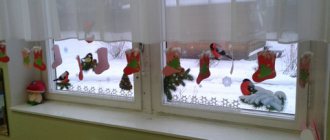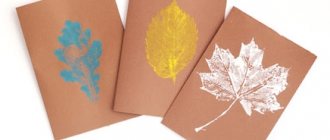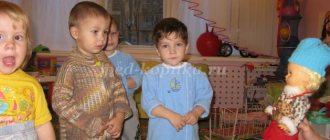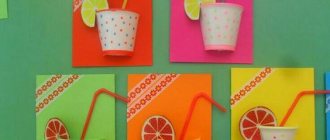49001_Konspekt po applikatsii vo 2 mladshey gruppe.docx
Abstract of cultural practice for application in the 2nd junior group topic: “Birdhouses for birds” Compiled by: Karnetskaya T.I. Program content: expand ideas about the characteristic signs of spring, about the way of life of birds in spring; to cultivate curiosity; Teach children to depict objects in appliqué. consisting of several parts, determine the shape (square, round, triangular); consolidate the names of colors, develop color perception, aesthetic taste; to form the ability to pre-lay out (in a certain sequence) finished parts of different shapes on a sheet of paper, composing an image and gluing them, to practice accuracy in working with glue, a brush, a napkin; refine and expand the vocabulary on the topic: “nest”, “birdhouse”, “rook”, “chirp”, “chirp”, “swallow”. Materials and equipment: presentation “Signs of Spring”, a bird, whatman paper with an image of a tree, PVA glue, brushes, red squares 9x9 cm, yellow circles with a diameter of 4 cm, green triangles with sides 10 cm, oilcloth, napkins for dipping for each child Preliminary work: conversations about spring, looking at reproductions about spring, observing on walks, reading stories: L. Tolstoy “The Bird Made a Nest”, “Spring Has Come”, poem in: A. Pleshcheev “Spring”, listening to birds singing, listening to songs about spring. Progress of activity: Educator: Guys, today I went to kindergarten, and it was so good, it was warm, the birds were singing, the grass was appearing, why do you think this is happening? What time of year is it now? Children: Spring! Educator: Correct! Let's see what other changes occur in nature in the spring. Viewing the presentation “Signs of Spring”: Children look at slides depicting the sun, snowdrifts, rotating fields, streams, trees, children’s clothes, migratory birds. Children tell what they see on each slide. Reading the poem: Spring is coming towards us with quick steps, And the snowdrifts are melting under her feet. Black thawed patches are visible in the fields. You can see very warm feet in spring. - What else happens in the spring? - Spring has not come alone, with its feathered friends - birds. They returned to us from warm countries and delight us with their singing. Looking at illustrations of birds. - Look how many birds there are here! What migratory birds do you know? Children: Starlings, rooks, swallows Physical education minute “Birds” Well, the birds, they flew. They flew and sat down, pecked at the grains, played in the pole, drank some water, washed the feathers, looked to the sides, and sat down quietly. Educator: Oh, look, a bird flew into our group (includes bird singing) what is she singing about, let's listen! - Guys, I understand, the bird is telling us that the birds have returned from warm countries, but they don’t have houses. Let's help the birds? Children: Yes Educator: You see, little bird, the guys are ready to help you, don’t worry! Do you know what the starling house is called? (Birdhouse) - What does a birdhouse consist of? What parts does it consist of? — Why do you need a window in a birdhouse? Children: So that birds fly into the house. Educator: Correct. Showing how to make an application. (At a separate table) On the table there is a Whatman paper with depicted tree trunks and one birdhouse. - Look, we have a tree on which we will hang a birdhouse. “I know how to make a birdhouse like this.” I take a square sheet of paper. What shape is my piece of paper? What colour? This will be the wall of the birdhouse. - Now I’ll take the circle. This will be the window in the birdhouse. What color is the window? What shape? I'll put the circle in the middle of the square. This will be the window. - Now I’ll take it and put the triangle against the wall. This will be the roof. What shape is the roof? What colour? Did you get a good birdhouse? “Now I’ll glue it on.” I will turn the circle over with the colored side down and coat the white side thoroughly with glue, especially the edges. And I will glue the window to the middle of the square piece of paper, on the wall of the birdhouse, and apply it with a napkin to remove excess glue. That's what a good window I got. - Now I’ll turn the wall over with the colored side down and also smear it well with glue, both in the middle and along the edges. Now I’ll carefully take the wall by the edges and take it and glue it to the wood. Like this, I’ll dab it with a napkin so it’s neat and press it so it sticks well. - What do I have left to stick on? That's right, the roof. What shape is the roof? What colour? What have I done now? (turned the roof over with the colored side down). Now, what needs to be done? (Spread the roof with glue). I will spread it carefully. Now I will take the roof to the tree and glue it on top of the wall. I will glue it carefully so that there is no gap between the roof and the wall. So that later the rain does not wet the birds. - And now, you yourself lay out each birdhouse on a sheet of paper. The children are taking their places - Everything has been laid out, correctly, well done. You can glue the birdhouse to a tree. Application “Birdhouse” During work, the teacher clarifies with the children the rules for working with glue and a brush, and asks them to clarify the color and shape of the parts individually. Summary of the lesson: Guys, I really enjoyed working with you today. You know so much about spring, about birds, I was glad that you wanted to help the birds, thank you. — Guys, what did you like in class today? Children's answers. - We are great today! We helped the birds, and now they can delight us with their songs. The teacher takes out pictures of starlings for each child. - Guys, look, the birds have arrived, let's play with them and show them the birdhouses. Game "Bird": Bird, small bird, Here is millet, And here is some water. Drink and eat quickly and fly to your family. Educator: The birds began to sing. They are happy that they will now also have houses.
Abstract of educational activities in the second junior group of kindergarten on application. Birdhouse
Abstract of OOD for children of the 2nd junior group
Application “Birdhouse” Program content
: To develop children’s ability to depict objects consisting of several parts (rectangular, round, triangular) in an application.
Clarify the meaning of colors, develop color perception. Strengthen the ability to use a napkin for dipping and carefully apply. Develop fine motor skills and the ability to enjoy the results of your work. Continue to instill in children responsiveness and a desire to help. Integration of domains
: Cognitive development.
Speech development. Social and communicative development. Artistic and aesthetic development. Physical development. Activation of the dictionary:
starling, birdhouse, wall, roof, window, shelf.
Individual work
: Develop accuracy, the ability to complete the work started.
Preliminary work:
observing birds on a walk, looking at a birdhouse and illustrations on the topic, clarifying its parts, artistic expression “We built a birdhouse...”, physical exercise “Starlings are flying from the south...”.
Materials and equipment: -
PVA glue - brushes - oilcloth - napkins - birdhouse - plot image of a starling - tinted paper of any soft tone, the size of half a landscape sheet - rectangle measuring 8x13cm;
1.5x5cm; a circle with a diameter of 3 cm, a triangle - a rosette with glue. -starling-origami. The course of direct educational activities Topic: “Birdhouse”
Children stand in a semicircle, the teacher is in front of them.
The teacher asks a riddle about the starling: I returned from distant lands to please you, friends. Spring came! Winter is over! "- Sang at the birdhouse (starling) Children:
Starling.
Educator:
That's right, starling.
Where does the starling live? Children:
In the house.
Educator:
Correct.
Who knows what his house is called? Children:
Birdhouse.
Educator:
Repeat Alan... (repeats).
Where did you see the birdhouse? (on a tree in a kindergarten, in the village...) Children sit down in their places. The teacher draws the children's attention to the sample birdhouse on A 3. Educator:
This is a birdhouse.
What geometric shapes does it consist of? This is a wall. Repeat. (Children repeat) What kind of geometric figure is a wall? Children:
Rectangle.
Educator
: That's right, it's a rectangle.
What's this? (points to the roof) Children:
This is the roof.
Educator:
That's right, it's the roof.
Repeat all “roof” (children repeat) - Roof, what kind of geometric figure is this? Children
: Triangle.
Educator:
Correct triangle.
What's this? (points to the window) Children:
Window.
Educator:
Correct.
Repeat the entire “window” (children repeat). Repeat Diana. (Diana repeats) -What kind of geometric figure is a window? Children:
Circle.
Educator:
Correct.
What is the window for? Children:
So that the starling can fly into the birdhouse, live, and hatch chicks.
Educator:
What is this?
(points to the shelf) Children:
Shelf.
Educator
: That's right, this is a shelf.
Repeat, children, “shelf” (children repeat) Shelf, what kind of geometric figure is this? Children:
Rectangle
Educator:
A starling flew to my birdhouse.
He has starling friends, but they don't have a birdhouse. Children, do you want to help them? Children:
Yes!
Educator:
Now I’ll show you how to glue a birdhouse. (Speaks with demonstration).
Look, children, first I take a large rectangle - this is the wall, turn it over and put it on oilcloth. I take a brush with three fingers to the piece of iron, pick up just a little bit of glue and smear it on the back white side of the rectangle, put it down the sheet in the middle, take a napkin and apply it. I take a triangle - this is the roof, spread it with glue and put it on the wall at the top, applying it with a napkin. Look, my roof is glued directly to the wall, exactly in the middle, so that it doesn’t fall. I take a circle - this is a window, spread it with glue and glue it to the wall a little higher, and apply it with a napkin. I take a small rectangle - this is a shelf. I smear glue on the shelf, glue it exactly under the window, like this, and apply it with a napkin. What a birdhouse it turned out to be, like a palace! Fizminutka
Starlings are flying from the south.
They want to live in a new house. It’s time for us to work. Build houses for the squirrels. Educator. Consolidation.
Now lay out the birdhouse on your sheets of paper.
There is no need to glue anything yet. Did you get a birdhouse? Children:
Yes!
Educator
: Now we sit down correctly and we can start working.
What geometric figure did we put below? Please show me how you will hold the brush? 2. Practical part.
Independent activity of children.
Individual assistance. Explanation. 3. Final part.
If the child has finished his work, the teacher praises him, takes the work, and hangs it on a magnetic board.
A bird, a starling (origami), “flies” to the birdhouse (the teacher sticks it to it). Educator:
Look, children, how the starlings rejoice at their new birdhouses.
Are you happy? Children:
Yes!!! We built a birdhouse - the House of the Merry Starling. We hung a birdhouse near our porch.
How a starling drove away thieves
Just one boy picked up a small birdling under a tree. He apparently fell out of the nest. The boy fed him. Skvorushka got used to his big friend and fell in love with him.
And the neighbors had a huge shepherd dog. The dog barked menacingly when someone stranger approached the door. And the squirrel adopted the bark from the shepherd. Everyone knows that starlings are mockingbirds; they are similar to parrots in this sense.
Occasionally, when the boy forgot to feed the bird on time, the starling would become offended, curse, bark menacingly at his friend, and even howl.
And it so happened that the boy suddenly developed a fever. He was taken to the hospital. The adults also left with him. There was only a squash left in the house.
This is where the thieves decided to make money at someone else’s expense. They picked up the keys, opened the lock and entered the house. Skvorushka is already very hungry. Hearing someone's steps, he thought it was his owners and began to swear at them. “Forgotten your squawk, woof-woof? Forgot... Woof? Where's the food? Woof!
But only the boy understood the starling's language. And the thieves heard the menacing barking of the shepherd, got scared and ran away! When the owners returned, they saw that someone was in their absence in the apartment. And the neighbors said that they heard barking and a dog howling from the neighbors, and then someone quickly ran away down the stairs.
The owners of the birdhouse guessed that it was their small bird that scared the thieves so much. What a wonderful bird the starling is.
After this incident, the boy and his mother made a birdhouse out of paper. The applique with a bird's house hung on the wall for a long time. She reminded her family about this amazing incident.
Application of geometric shapes
This story can be successfully told to both middle and high school students. It will surprise even younger schoolchildren. But the task for four- to five-year-old children can be made more difficult.
Now the children should be asked to cut out a rectangle and a triangle for the bird’s house themselves. A circle that will imitate the entrance hole to a birdhouse can be prepared for the children in advance. It is still recommended that children be given templates of rectangles and triangles in advance. The teacher also gives the task: cut out the wall of the house from red paper, and the triangle roof from blue paper.
The task turned out to be quite complex - the applique “Birdhouse” made up of self-cut geometric shapes.
The middle group also consolidates the knowledge acquired in mathematics classes. After all, they have to work not just with templates, but with rectangles, triangles and circles.
GCD summary: “Birdhouse for migratory birds”
(second junior group)
Program content:
Teach children to depict objects consisting of several parts in appliqué; determine the shape of the parts (rectangular, round, triangular). Improve your knowledge of colors. Develop color perception. Continue to introduce children to migratory birds, name familiar birds. Foster feelings of kindness and love for birds.
Material used:
Swallow glove puppet, images of migratory birds, ½ landscape white sheet, geometric figures made of colored paper, Whatman paper, large-size geometric figures, a cardboard bird, a disc with a recording of bird voices.
Progress of direct educational activities:
Surprise moment.
A bird “flies” into the group room. The teacher announces the “guest” and greets the children.
Educator: “Look, we have a guest, this is a migratory bird - a swallow. The swallow is the messenger of what time of year?”
Listens to children's answers.
Educator: “That's right, guys. In the spring, grass appears, buds bloom, and insects wake up after hibernation. “Familiar food appears for the birds, and they return to us from warm countries.”
The teacher shows pictures of migratory birds and lists them, the children pronounce the names of the birds. Then the teacher, turning to each child, shows a picture of birds and asks them to name them.
Physical exercise “The birds have flown.”
| The birds have arrived | Cross your palms in the form of wings and imitate the flight of birds |
| Fluffed the feathers | Shake both hands frequently |
| They turn their heads | Move your head left and right |
| They want to fly away | Run, imitate the flight of birds |
| Shoo! Shoo! They flew away! Behind the blizzard, behind the blizzard. |
Educator: “How will the birds peck the grains?” With their fingers clenched into their beaks, the children imitate how birds peck grains and say “Beak-beak-beak.”
Educator: “Guys, unfortunately, in early spring there is little food for the birds, so people must feed them. And for this you need birdhouses - houses for birds. Let’s make birdhouses for our swallow and all migratory birds.”
The teacher shows a picture of a birdhouse and names the parts it consists of, noting that these parts look like geometric shapes. The birdhouse itself is a rectangle, the roof is a triangle, and the window is a circle.
The teacher invites the children to make a birdhouse together with him, and explains in what order its components need to be glued, showing this on whatman paper. The teacher, together with the children, pronounces the color of the birdhouse’s components (the roof is red, the walls are blue, the window is yellow). The teacher glues a perch to a large birdhouse, onto which the bird “flew”.
Educator: “Guys, look, the first bird has flown into the birdhouse! Listen, she says “thank you” to us in her bird language.” The sounds of birds are heard in the group room. The teacher offers to “fly” with the bird again. Then the guest says goodbye and promises to fly to the birdhouse every day.
Where is the Birdhouse application used?
Those people for whom manual labor is a hobby always have something to occupy themselves with. They will find use for even a small piece of fabric or a piece of wallpaper.
The Birdhouse applique is very interesting in this regard. It will help decorate clothes and bedding. You can also make a wonderful postcard on this topic with your own hands using the scrapbooking technique. And a panel on the wall will bring a fresh air into the interior. And for kids, a manual labor class, in which they will create a Birdhouse application, will be a real discovery. After all, they will learn a lot of new and interesting things about the life of birds.
Manual labor in the second junior group
Children between three and four years old are still quite inept. They find it difficult to work with scissors. Therefore, it is best to offer kids ready-made cut out templates. Having told at the beginning of classes that in the spring many birds, including starlings, fly to us in the middle zone, the teacher invites the children to make a beautiful picture. To do this, they need to stick on the parts that were distributed to them before class in a certain way.
As a result, the children should get a “Birdhouse” applique. Junior group 2 copes with this task quite easily. And after everything is ready, you can tell the kids an amazing story.







